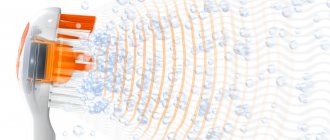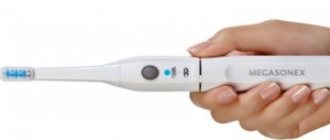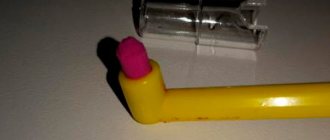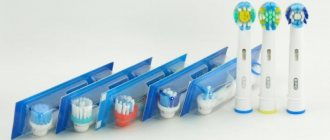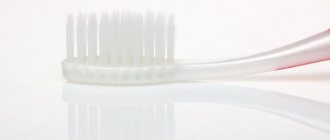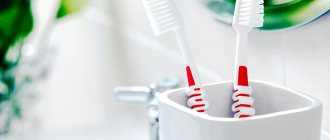It's no secret that classic toothbrushes are unable to clean hard-to-reach areas and completely remove plaque from the enamel.
Because of this, the risk of tooth loss increases significantly.
An ultrasonic toothbrush can help prevent dental problems..
This is a modern device that allows you to independently thoroughly clean the oral cavity at a professional level. After reading the article, you will be able to understand how to choose a device yourself, how it works and how to use it.
What is an ultrasonic toothbrush?
Reference! An ultrasonic toothbrush is one of the types of electric brushes designed for professional hygienic oral care at home.
In appearance , the device resembles a classic device for cleaning the oral cavity, since the design is based on a comfortable handle and tip with a small working head and bristles that vibrate during operation.
Cleansing is carried out in two ways: ultrasonic and mechanical .
This allows you to obtain a high therapeutic effect, which is impossible to achieve using a regular toothbrush.
Important parameters
When choosing a toothbrush, you need to pay attention to the materials and characteristics of the working part. The most important thing here is the diameter and shape of the head, the density, location and stiffness of the bristles. A regular electric brush has a round head with a diameter of 1.5 cm. The hardness depends on your needs and the condition of the dentin. If the enamel is weakened, there are problems with sensitivity, or the brush is intended for a child, soft bristles are needed. Medium hardness pile is a universal solution for those who do not have any special problems. High hardness is only needed in certain cases and only after consultation with a dentist.
In sound and ultrasonic gadgets, the shape of the head is not important - it does not in any way affect the propagation of high-frequency waves. But the arrangement of the bristles should reproduce the shape of the bowl - this will make cleaning more effective. The material of the working part is special plastic. Brushes with natural bristles are practically not found on sale and are recommended only for those who suffer from allergies.
Principle of operation
Cleaning teeth with an ultrasonic brush is carried out by a motor located inside the handle, which triggers a piezoceramic plate that produces oscillatory waves.
Under the influence of ultrasound, the villi begin to move, eliminating bacterial plaque and food particles.
Need to know! During the cleaning process with an ultrasonic type device, the oral tissues are slightly heated.
Thanks to this, the active components of the toothpaste penetrate deep and have a positive effect on the condition of the teeth.
How ultrasound is used to clean teeth
The development of an ultrasonic brush began after scientists proved that waves of this length destroy harmful microorganisms.
In modern models, an ultrasonic wave is created by a mechanism located inside the handle, which transmits vibrations to piezoceramic plates. The resulting ultrasound has a destructive effect on dental plaque and pathogenic bacteria.
Many people are concerned about the question: does ultrasound harm the human body? Dozens of independent studies have shown that there is no harm when the radiation volume is no higher than 120 dB. The volume of brushes (even the most powerful ones) reaches a maximum of 40 dB.
Main advantages of the device
When choosing an oral hygiene product, the first question that arises is: “What type of brush is best to use – regular, electric, sonic or ultrasonic?”
When using a regular (manual) brush, the effectiveness depends entirely on how well the person brushes their teeth.
An electric toothbrush vibrates the bristles from bottom to top. Cleaning is very easy, but there is a risk of damage to tooth enamel and mucous membranes. The result of brushing may be that bacteria get under the gum, where they will continue their destructive actions.
A sonic brush is intermediate between manual and ultrasonic. Its vibrations (with a frequency of up to 20 kHz) help destroy microorganisms, but when cleaning it, physical effort is also required.
The efficiency of an ultrasonic brush is the same as that of electric models. There is a complete destruction of bacteria and cleaning of plaque, but the effect also extends to soft tissues, in the gum pockets. Ultrasound also prevents the appearance of microbes on the bristles.
American scientists from the School of Dentistry operating at Case Western University, as a result of an experiment, determined that ultrasonic brushes are most effective in removing plaque, preventing bleeding gums and treating gingivitis. Their advantage in these aspects over conventional models reaches from 200 to 450%!
Indications for use
The ultrasonic brush has no contraindications, since it does not cause any harm to the body. This hygiene product is useful for various problems with teeth or gums: if braces or dentures are installed, periodontal disease is present, etc.
Here are some of the problems that an ultrasonic brush can successfully solve:
- Preventing the formation of tartar. Prevention of this disease includes removing plaque caused by coffee and nicotine. Special cone-shaped nozzles help remove even dense deposits.
- Improvement of gums. Ultrasonic waves penetrate the gums to a depth of 6 mm, and sometimes up to 12 mm, destroying pathogenic bacteria. Thanks to this effect, the intensity of blood microcirculation increases. Ultrasound prevents the occurrence of gingivitis, periodontitis, stomatitis and other diseases. To care for problem gums, an irrigator is often used in combination with ultrasound.
- Eliminate bad breath. Removal of harmful microorganisms leads to the disappearance of unpleasant odors. Keeping the bristles clean ensures that these bacteria are not reintroduced into your mouth when brushing again.
- Cleaning installed implants and dentures. Ultrasound penetrates the soft tissue and destroys the accumulation of bacteria under the gums at the site where the dentures are installed. Toothbrushes have a power that is safe for orthopedic structures. They can only be harmed by a professional scaler, which is used in dental clinics to remove tartar.
- Convenient maintenance of braces. There is no risk that the bristles will get stuck in the structure. Ultrasound removes plaque in hard-to-reach places - under arches and clasps.
- Assistance in recovery after surgical operations (tooth extraction, implant installation). Under the influence of ultrasound, wounds heal much faster.
Application of ultrasonic brush
The main difference between the ultrasonic model and brushes with a different operating principle is the absence of the usual cleaning movements. Indeed, in this case, there is no need for mechanical influences to remove plaque.
The procedure consists of several stages:
- the brush head is moistened with running water;
- apply for 5-10 seconds to each of the groups of teeth being cleaned;
- After cleaning, rinse the brush with water and rinse your mouth.
There are recommendations for using toothpaste in combination with ultrasound - this enhances the cleaning effect. But you don't have to do that.
Which ultrasonic toothbrush is most effective?
Many models of ultrasonic brushes have proven themselves well among users. Popular: SMILEX, MEGASONEX, Donfeel, Emmi-Dent, ASAHI IRICA, ULTRASONEX. Their differences lie in the design, the specific structure of the bristles and the frequency of ultrasound.
Each brush has an individual design, its own bristle characteristics and sound wave frequency. But the only device that operates with 100% ultrasound is the Emmi-dent, created by respected medical innovator Hugo Hoselfelder. Its power is 0.2 Watt, the number of ultrasonic vibrations is 96 per minute. This brush destroys plaque and harmful bacteria without creating any health hazard.
A special toothpaste has also been created for this model. Its operating principle is radically different from conventional hygiene products. Apply the paste not to the brush, but to the outer and inner sides of the teeth. Ultrasound-foamed paste in the form of nanobubbles penetrates into places inaccessible to ordinary bristles and destroys harmful bacteria accumulated there and inside the gums. The depth of such penetration into soft tissue is 12 mm.
Emmi-dent is not a cheap brush, but it is completely worth the cost of purchase.
Advantages
Compared to classic devices, ultrasonic toothbrushes do a better job of cleaning the oral cavity from dirt.
They are suitable for use for the prevention of dental diseases.
However, these are far from the only advantages of an electric device.
Important! Among the main advantages of using ultrasonic dental devices, dentists highlight:
- high processing efficiency;
- gradual loosening of mineralized plaque;
- Possibility of use for sensitive teeth;
- lightening the enamel by several tones;
- performing a healing gum massage;
- quick and gentle cleaning of teeth;
- deep penetration of paste components into tissues;
- minimizing the risk of abrasion of tooth enamel;
- saving time and toothpaste;
- the ability to brush teeth in the presence of orthodontic installations;
- a small list of contraindications for use.
Top best ultrasound brushes 2022
Flagship devices are not cheap. But as studies have shown, they are the ones of the highest quality compared to other models.
Philips Sonicare DiamondClean Smart HX9954/57
This is one of the best brushes, which has the function of 5 operating modes and 3 power settings.
- It is equipped with a built-in timer, as well as interchangeable nozzles - classic, for cleaning the tongue, oval and a nozzle for delicate cleaning.
- Plus, the device also has an antibacterial effect and can be used to whiten teeth.
A special feature of this purchase is its synchronization with your phone, thanks to which you can find out information about the state of your dentition in a special application and receive useful tips on oral care.
The cost of such a toothbrush is from 18 thousand rubles.
Megasonex
This brush has 3 modes for different types of teeth - sensitive, very sensitive and normal.
- There is no noise during operation, and the kit includes 2 attachments.
- The brush is equipped with a charger and a travel case, which is very convenient when traveling.
The effect of the brush is no different from the model presented above - it also effectively and gently cleanses plaque from the teeth and has a bactericidal effect.
You can buy a toothbrush from this company from 9 thousand rubles
Philips Sonicare FlexCare Platinum HX9182/32
It is also not inferior to its counterparts in the quality of cleaning teeth. The device has 3 operating modes and 2 built-in attachments.
- The kit also includes a charger, a portable case and a disinfectant for the device.
- Suitable for both daily teeth cleaning and teeth whitening.
- Using this model will allow you to clean even hard-to-reach areas of the oral cavity.
The standard price of the device is 11 thousand rubles
Flaws
An ultrasonic toothbrush has a gentle effect on tooth enamel and gums; however, such devices have a number of disadvantages.
Stay up to date! The disadvantages of electrical appliances include:
- high risk of destruction of areas of enamel that have lost their mineral components;
- the possibility of seals falling out if the device is used incorrectly;
- the need to regularly change expensive attachments;
- high cost of the device.
Benefits of electric toothbrushes
- Electric brushes are definitely better at getting rid of bacterial plaque. After using them, gum inflammation is significantly reduced.
- Anyone can operate an electric toothbrush, including small children. And, in addition, the process of brushing teeth with such a device will arouse interest in the child and can easily accustom him to regular and proper oral hygiene.
- Even for a large family, only one device will be enough. You will only need to change the attachments for each family member.
- Undoubted savings on toothpaste.
- A special built-in sensor will warn you if you try to put strong pressure on your teeth and prevent damage to the enamel.
What paste is recommended to use?
Some manufacturers produce special toothpastes with a gentle abrasive system.
It is these pastes that are recommended to be used in conjunction with an electric ultrasonic device.
Note! You can also use regular pastes that do not contain fine particles for daily oral care.
Experts advise purchasing toothpastes labeled “For electric toothbrushes” , having first studied the composition of the cleaning product.
It is desirable that the paste contains phosphorus and calcium, which help strengthen and whiten tooth enamel.
Sequence of application and use
To get the maximum benefit from using an ultrasonic electric brush, you need to follow several important rules :
- Before turning on the device, check its charge .
- Brush your teeth twice a day with a small amount of toothpaste.
- Hold the product at an angle of 45 degrees when cleaning the side surfaces of the teeth from the inside and outside.
- Slowly move the work head in one direction. You should stay on one tooth for no more than three seconds.
- When brushing your front teeth, hold the device vertically.
- When cleaning the chewing teeth, move the brush to a horizontal position.
- Carry out the procedure in such a way that the villi affect not only the enamel, but also the gums.
- After turning off the device, rinse the bristles well with running water and rinse your mouth.
To maintain the ultrasonic cleaning device in working condition, it is necessary to charge the battery or change the batteries in a timely manner. Also, do not immerse the device in water.
Contraindications
Remember! Some patients will still have to refuse to undergo the procedure of cleansing the oral cavity with such a device.
The use of the device is contraindicated in the presence of certain pathologies:
- diabetes ; _
- oncological diseases;
- periodontitis;
- white spots on enamel;
- severe bleeding gums .
It is also not recommended to use the electric device for people with installed pacemakers, fillings, pregnant or lactating women.
Are they suitable for children?
Ultrasonic toothbrush models are ideal for children .
You should know! With their help, the baby will be able to thoroughly clean the teeth and perform a light massage of the gums, which is necessary to increase the stability of periodontal tissues and stimulate metabolic processes.
Children can start using the device as early as five years of age under adult supervision.
All models of toothbrushes intended for children are designed taking into account the development of children's teeth. Therefore, children should not use adult hygiene devices.
Selection rules
When choosing an electric ultrasonic brush, you should consider the following characteristics:
- Additional functions. The presence of a timer, pressure sensors, a wear indicator and a function for getting used to the device can simplify the procedure and make it as comfortable as possible. But you shouldn’t overpay for devices equipped with functions that are not necessary.
- The shape of the working head and the degree of stiffness of the bristles. Ultrasonic devices are distinguished by an elongated head shape and medium-hard bristles. Such devices are ideal for consumers with healthy teeth. However, sometimes the included attachments have a rounded working head and soft bristles, suitable for people with hypersensitive teeth.
- Type of food. Different models of brushes can be battery-powered or battery-powered. Therefore, when choosing a device, you should consider your preferences. Many consumers choose devices that do not require connection to an outlet, but some buyers prefer to use more mobile devices.
- Age category. Products for children are ineffective against adults. Because due to a small amount of vibration, they will not be able to properly clean the teeth. Manufacturers produce lightweight and compact models especially for children. They are comfortable to hold in your hand, they do not slip out and are absolutely safe for babies.
- Manufacturer . In today's market you can find inexpensive ultrasonic devices made in China. But experts recommend purchasing devices from proven and reliable manufacturers who guarantee the quality of their products and their durability. The most famous brands are Oral B, Panasonic and Philips - you should pay attention to them first.
Can such a brush cause any harm?
Need to know! The harmful effects of this model of electric brush are as follows:
- Periodontitis. When the apex of the tooth root becomes inflamed, bags of pus (cysts) form. The disease can be asymptomatic until the immune defense decreases or something provokes an exacerbation, which consists of pain when biting food and swelling of the gums. Using an ultrasonic brush can trigger such an aggravation. Therefore, if there is pain in the teeth, gums, or swelling, it cannot be used.
- Teeth with fillings. In healed teeth, ultrasonic waves fluctuate differently. The passage of vibration depends on the material, so a constant “conflict” causes a loosening of the connection between the tooth and the filling. If the filling is light-polymer and glued with a special adhesive glue, then its destruction causes the filling to fall out.
- Demineralization of enamel. With such an illness, the enamel becomes fragile and porous, but this is not visible to the average person outwardly, since there are no chips or caries. But over time, the impact of the brush will increase tooth decay, and visible changes will begin. Inexperienced dentists sometimes use an ultrasonic tip to clean demineralized teeth. This immediately causes irregularities to appear on the enamel. Such parts of the teeth will have to be sealed, otherwise caries will begin.
- Chronic periodontitis. With this disease, bone tissue in periodontal pockets is replaced by granulation tissue. Inside it, a huge number of bacteria and osteoclast cells are formed, which resolve bone tissue. Under the influence of ultrasound, they become more active and begin to destroy tissue faster, which leads to loosening and tooth loss. But for the prevention of periodontitis with healthy teeth and gums, an ultrasonic brush is perfect.
- Gum disease in the acute stage. Due to the beating of the ultrasonic wave, the infection, manifested in swelling, inflammation and pain, will begin to spread faster and the condition of the oral cavity will worsen.
- Pregnancy. In the initial stages, you should also not use this model of electric brush. Since many doctors equate the wave vibrations from it with those during ultrasound diagnostics and believe that this can provoke a miscarriage.
You should know! Due to the presence of contraindications and possible harm from using an ultrasonic brush, it is better to consult a doctor before purchasing it.
Can it negatively affect fillings?
Keep in mind! Ultrasonic vibrational waves are capable of penetrating deep into the tissues of the oral cavity by 4-5 mm.
This creates vibrations of various orthopedic structures installed on the teeth.
This problem affects not only braces, since any foreign materials differ in their physical properties from tooth tissue.
For this reason, during the passage of an ultrasonic wave, all artificial elements are subject to vibration.
As a , there is a gradual destruction of the connecting component with subsequent loss of the filling .
Consumer Reviews
Below are some reviews from customers and dentists. If you have something to say, leave your feedback in the comments below the article, it will be useful to our readers.
Ekaterina Sviridova, Yaroslav.
After the tartar removal procedure, the dentist advised me to change my regular brush to an ultrasonic model.
To be honest, I had never heard of such a device, but the doctor gave some advice on choosing a brush and on the same day I purchased a device from Oral B.
I’ve been using it for almost 3 months, not every day, 4 times a week, so as not to harm my teeth. I am completely satisfied with the brush; it cleans hard-to-reach places well and prevents the formation of tartar. I recommend.
Mikhail But-Gusaim, Moscow.
All ultrasonic brushes from leading brands are expensive, and since I didn’t want to spend large sums on a device that might turn out to be ineffective, I decided to buy a Donfeel HSD-005 device from a Russian manufacturer.
A brush with two operating modes and a comfortable handle, runs on batteries.
The working head has soft fluff, which I immediately identified as a minus, although it really does clean well. It was not possible to get rid of tartar, but overall the effect is good.
Andrey Skomorokh, Stavropol.
I purchased an ultrasonic brush from Philips about three years ago. At that time, it was one of the most budget-friendly and simple models without additional functions such as gum massage or display.
Despite its modest technical characteristics, the brush cleans teeth efficiently and even removes tartar little by little.
It takes a long time to charge (almost a day), but the charge lasts for 2-3 weeks. In three years I’ve used a regular brush 4 times and I don’t plan to go back to it.
The most successful models
Today on sale you can find models that are actively promoted by dental clinics, as well as products that have “independently” gained popularity among customers. In the first case, we are talking about the best samples with the fewest contraindications, but with a high cost. In the second - about a product with the best combination of price and ease of use.
Emmi-dent
Emmi-dent is the only ultrasonic electric brush that you can use without scrubbing. The antibacterial effect of the ultrasonic wave extends to a depth of 12 mm (from the upper edge of the gums).
The user simply brings the brush to the teeth and leaves it for a short time. Specially developed toothpaste turns into millions of bubbles under the influence of an ultrasonic wave. When they burst, the microbubbles clear plaque from the interdental spaces and cracks in the enamel.
It has been noticed that if you constantly brush your teeth with Emmi-dent, you can get rid of the manifestations of herpes and aphthous stomatitis in the oral cavity in a short time.
A significant disadvantage of the device is the price. You will have to spend more than 12 thousand rubles to purchase the kit, then you will need to regularly purchase specialized toothpaste.
Philips Sonicare
Unlike the previous copy, the electric ultrasonic brush belongs to the middle price segment. In two minutes, it makes the same number of movements as a regular brush in the user’s hands. The effect of use is noticeable within one to two weeks:
- the smell disappears;
- plaque disappears;
- Tartars are reduced.
Using the Philips Sonicare ultrasonic toothbrush, you can restore the natural whiteness of enamel even with constant consumption of strong tea infusions, red wine, and coffee.
Donfeel HSD-015
Having the same cost as the average electric specimen, Donfeel acts in three directions at once:
- Cleans great.
- Treats gums.
- Provides prevention of caries and tartar.
Electric analogues provide only high-quality cleaning. A big advantage of Donfeel is its built-in UV disinfection system.
Oral B
The undisputed leader is the Oral Bee toothbrush. The reason for its use may be such indications as pathological growth of carious lesions, plaque that is difficult to remove, and an unpleasant odor that remains even after rinsing and cleaning.
The Oral B device can be used by people with braces, fillings and implants. In case of increased sensitivity, as well as during the period of adaptation, the Sensitive mode is recommended; its presence is one of the advantages of Oral B.
Megasonex
Another representative of expensive devices is the Megasonex electric toothbrush. When using it, you can choose one of three modes:
- gentle;
- intensive;
- ultrasound.
When working in the “Ultrasound” mode, the electric brush does not perform mechanical vibrations - the effect is carried out only through an ultrasonic wave. The model has gained popularity due to its ergonomics and attractive design.
Dentist reviews
Today, brushing teeth using sound vibrations at home is available to almost every person.
Unfortunately, I cannot call the invention of the ultrasonic brush an advantage of technological progress.
Indeed, with the advent of electrical devices for oral care, the number of patients complaining of constant pain in the teeth and the development of inflammatory processes has increased.
I do not recommend using such brushes on an ongoing basis.
Dental devices with ultrasonic action have a beneficial effect on the condition of teeth and gums, thoroughly cleaning the oral cavity from pathogenic bacteria, food debris between teeth and plaque.
I believe that fears about the negative impact of ultrasound on the body are groundless, since the power of ultrasonic brushes is low.
It allows waves to penetrate a layer of 4-5 mm - this is enough to safely remove contaminants.
The effect of ultrasound on enamel
Some patients have whitish spots on the enamel - foci of demineralization, which are a harbinger of caries. The enamel surface in these places is porous and fragile, even though the damage is not yet visible.
Only an experienced dentist can properly clean (without touching such areas). When areas of demineralization are exposed to ultrasound, the top layer of enamel is destroyed, irregularities and other defects appear. Using an ultrasonic brush can cause significant damage that will have to be filled. If your teeth are healthy, using an ultrasonic brush is absolutely safe.
